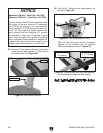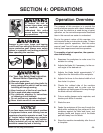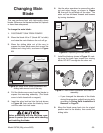
Thin Kerf Blade: A blade with thinner kerf than
a standard blade. Since the spreader/riving knife
included with this table saw is sized for standard
blades, thin kerf blades cannot be used on this
saw unless they meet the Blade Requirements
specified in this manual; otherwise, they will
increase the risk of kickback.
Figure 45.
Crosscut blade features:
• Best for cutting across the grain
• 60-80 teeth
• Alternate top bevel tooth profile
• Small hook angle and a shallow gullet
Alternate
Top
Bevel
Figure 46.
Combination blade features:
• Designed to cut both with and across grain
• 40-50 teeth
• Alternate top bevel and flat, or alternate top
bevel and raker tooth profile
• Teeth are arranged in groups
• Gullets are small and shallow (similar to a
cross-cut blade), then large and deep (similar
to a ripping blade
Alternate
Top
Bevel
and
Flat
Figure 47.
Laminate blade features:
• Best for cutting plywood or veneer
• 40-80 teeth
• Triple chip tooth profile
• Very shallow gullet
Triple
Chip
Blade
Figure 48.
Dado Blades
Stacked Dado Blade (see below): Multiple
blades are stacked together to control the cutting
width. Stacked dado blades are more expensive
than wobble blades, but typically produce higher
quality results.
Wobble Dado Blade: A single blade mounted at
a slight angle on an arbor hub. The blade angle is
adjustable on the hub, and the width of the dado
cut is controlled by the angle setting of the blade.


















